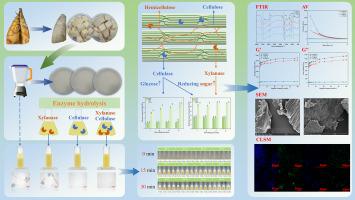Combined wet milling and enzymatic refining of bamboo shoot suspensions: Microstructure, stability, and rheological properties
IF 6.8
1区 农林科学
Q1 FOOD SCIENCE & TECHNOLOGY
Innovative Food Science & Emerging Technologies
Pub Date : 2025-08-20
DOI:10.1016/j.ifset.2025.104176
引用次数: 0
Abstract
Bamboo shoots (Dendrocalamus brandisii), rich sources of protein (∼28 % crude) and fiber, are severely limited in their food industry applications by high perishability and poor storage stability. This study introduces a one-pot, two-step green processing strategy, combining wet milling with enzymatic hydrolysis (cellulase/xylanase), to produce a stable and ready-to-eat bamboo shoot suspension. The synergistic treatment restructured native fibrous architecture into micron-scale fragments, as confirmed by microstructural (OM, SEM, CLSM) and FTIR spectroscopic analyses. Under conditions (2 % solids, 65 min wet milling, combined cellulase and xylanase treatment for 12 h), the suspension reached a maximum glucose content of 14.1 g/100g DW. All suspensions exhibited shear-thinning behavior; cellulase treatment, in particular, markedly reduced viscoelastic moduli, leading to a more fluid-like yet remarkably stable suspension. This study demonstrates a clean-label strategy for valorizing underutilized bamboo biomass into structured and ready-to-eat food systems, which offers mechanistic insights into the microstructure–stability relationship of plant-based suspensions for their broader application in functional food formulations.

竹笋悬浮液的湿磨和酶炼:微观结构、稳定性和流变性能
竹笋(Dendrocalamus brandisii)富含蛋白质(粗含量约28%)和纤维,但由于其易腐烂和储存稳定性差,严重限制了其在食品工业中的应用。本研究介绍了一锅两步绿色加工策略,将湿磨与酶解(纤维素酶/木聚糖酶)相结合,以生产稳定的即食竹笋悬浮液。通过显微结构(OM, SEM, CLSM)和FTIR光谱分析证实,协同处理将天然纤维结构重组为微米级碎片。在固含量为2%、湿磨65 min、纤维素酶和木聚糖酶联合处理12 h的条件下,悬浮液中葡萄糖含量最高可达14.1 g/100g DW。所有悬浮液均表现出剪切减薄行为;纤维素酶处理,特别是,显著降低粘弹性模量,导致更流体样,但非常稳定的悬浮液。本研究展示了一种清洁标签策略,可将未充分利用的竹子生物质转化为结构化和即食食品系统,这为植物基悬浮液的微观结构-稳定性关系提供了机制见解,有助于其在功能食品配方中的更广泛应用。
本文章由计算机程序翻译,如有差异,请以英文原文为准。
求助全文
约1分钟内获得全文
求助全文
来源期刊
CiteScore
12.00
自引率
6.10%
发文量
259
审稿时长
25 days
期刊介绍:
Innovative Food Science and Emerging Technologies (IFSET) aims to provide the highest quality original contributions and few, mainly upon invitation, reviews on and highly innovative developments in food science and emerging food process technologies. The significance of the results either for the science community or for industrial R&D groups must be specified. Papers submitted must be of highest scientific quality and only those advancing current scientific knowledge and understanding or with technical relevance will be considered.

 求助内容:
求助内容: 应助结果提醒方式:
应助结果提醒方式:


